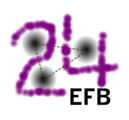Speaker
Description
The electron-hole bound states (excitons) in the semiconductor quantum wells (QW) are remarkable examples of Coulomb systems, in which the external potential of the heterostructure plays a role of the third particle, thus making such a system to be a three-body one. The exciton states and the exciton-light coupling in heterostructures with QWs have been experimentally and theoretically studied for several decades [1,2,3]. The quality of heterostructures is continuously growing and experimental samples with excellent properties have recently become available in many laboratories. Measurements of the reflectance spectra of the high-quality heterostructures show that the accurate data on the exciton energies and radiative as well as nonradiative broadenings can be easily obtained [4,5]. In this context, the high quality of samples requires the improved precision of theoretical modeling of the exciton states and resonances. Therefore, such problems gradually draw attention of the few-body community [6,7].
In this report, we present the results of an accurate modeling of the exciton states as well as the corresponding radiative decay rates. The energies of the ground and excited states of excitons in GaAs-based finite square QWs of various widths and alloy compositions are calculated. This type of QWs is widely experimentally and theoretically studied now as a model heterostructure. Determination of the exciton states is achieved by studying the three-dimensional Schroedinger equation for the exciton in a QW and analysing the spectrum of the Schroedinger operator. The eigenvalue problem is solved numerically using the finite-difference discretization scheme [5] and properly taking into account the discontinuities of the material parameters at the interfaces of the QW [8]. We show that the numerical method is asymptotically exact, thus it allows us to obtain accurate exciton states for a wide range of QW widths and potential profiles [9]. The calculated bound states of electron-hole pairs in GaAs/AlGaAs and InGaAs/GaAs QWs are classified according to their quantum-confinement and Coulomb nature [10]. The accurate radiative decay rates for the calculated s-like exciton states are obtained for QW widths up to 100 nm. Calculated data are confronted with the experimental reflectance spectra measured for high-quality InGaAs/GaAs heterostructures with QWs. The calculated values are in good agreement with the experimental data.
Financial support from the Russian Science Foundation (grant No. 19-72-20039) is acknowledged. The calculations were carried out using the facilities of the Computational Center of SPbU.
[1] G. Bastard, E. E. Mendez, L. L. Chang and L. Esaki, Phys. Rev. B 26 (1982) 1974.
[2] R. C. Iotti, L. C. Andreani, Phys. Rev. B 56 (1997) 3922.
[3] E. L. Ivchenko, Optical spectroscopy of semiconductor nanostructure} (Harrow: Alpha Sci. Int., 2005).
[4] A. V. Trifonov et al., Phys. Rev. B 91 (2015) 115307.
[5] E. S. Khramtsov, P. A. Belov, P. S. Grigoryev et al., J. Appl. Phys. 119 (2016) 184301.
[6] O. L. Berman, G. Gumbs, and R. Ya. Kezerashvili, Phys. Rev. B 96 (2017) 014505.
[7] R. Combescot, Phys. Rev. X 7 (2017) 041035.
[8] P. A. Belov, E. S. Khramtsov, J. Phys.: Conf. Ser. 816 (2017) 012018.
[9] P. S. Grigoryev, A. S. Kurdyubov, M. S. Kuznetsova et al., Superlatt. Microstr. 97 (2016) 452.
[10] P. A. Belov, Semiconductors 52 (2018) 1791.




